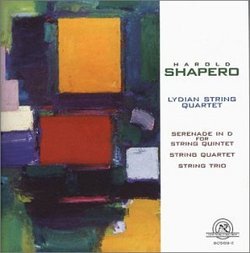| All Artists: Harold Samuel Shapero, Lydian String Quartet Title: Harold Shapero - Chamber Music Members Wishing: 1 Total Copies: 0 Label: New World Records Original Release Date: 1/1/2003 Re-Release Date: 7/29/2003 Genre: Classical Styles: Chamber Music, Historical Periods, Classical (c.1770-1830) Number of Discs: 1 SwapaCD Credits: 1 UPC: 093228056928 |
Search - Harold Samuel Shapero, Lydian String Quartet :: Harold Shapero - Chamber Music
 | Harold Samuel Shapero, Lydian String Quartet Harold Shapero - Chamber Music Genre: Classical
The revival of Harold Shapero?s Symphony for Classical Orchestra by André Previn and the Los Angeles Philharmonic in 1988 spearheaded a renewed interest in his long-neglected major works. Nevertheless, Shapero?s (b. 1... more » |
Larger Image |
CD Details
Synopsis
Album Description
The revival of Harold Shapero?s Symphony for Classical Orchestra by André Previn and the Los Angeles Philharmonic in 1988 spearheaded a renewed interest in his long-neglected major works. Nevertheless, Shapero?s (b. 1920) vastly underrated portfolio today remains the great undiscovered treasure trove of American neoclassicism. The String Trio, the String Quartet, the Serenade in D encompass a uniquely broad-based introduction to Shapero?s compositional thought processes. In this welcome release, the record-listening public is afforded an excellent opportunity to experience first-hand these important examples from his infrequently encountered body of work. The String Trio (1937) is a very early work written under the tutelage of Ernst Køenek. It was composed in approximately one week?s time on his teacher?s suggestion that Shapero look at Alban Berg?s Lyric Suite and produce something like it. Not surprisingly, the influence of this piece and of Køenek, best remembered as an early champion of serial composition, are most keenly felt here. The String Quartet (1941) bears a dedication to Walter Piston, his primary teacher during his undergraduate years at Harvard. Like the Trio, it?s by and large an intense, edgy opus, but the sound world encountered is less clangorous, demonstrating kinship to Piston?s oeuvre not only in its jagged rhythmic gestures but also in its non-triadic yet scalar harmonies built from stacked fifths. Like Aaron Copland?s Sextet for Clarinet, Piano, and Strings, the Serenade in D is a chamber arrangement of a large ensemble opus that was motivated by practical concerns. Completed in 1945, it?s a major entry from this composer?s wartime-era output, ambitious in scope and sizable in duration. Here we find the composer at the height of his powers; the astringency of the Trio and raw drive of the Quartet give way to a manner of expression both urbane and supremely confident. While there?s plenty of energy encountered here, it is channeled into delineating finely chiseled, often deliberate gestures that show an inimitable sense of self. Not unexpectedly, the work is unambiguously neoclassic, more keenly aware of music from earlier eras than that of any other composer writing in this style. Of related interest: 80373 Harold Shapero?Symphony for Classical Orchestra 80402 Harold Shapero?Piano Sonatas Nos. 1, 2, & 3 80536 Harold Shapero?Four-Hand Sonata for Piano

 Track Listings (12) - Disc #1
Track Listings (12) - Disc #1